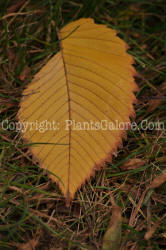|
|
 |
Ulmus americana |
 |
American Elm also
called White, Gray, Water or Swamp Elm |
 |
 |
  2
to 9 2
to 9 |
 |
Newfoundland,
Canada to Florida, west to the foot of the Rockies
-
United States |
|
 |
|
 |
 |
Upright, gracefully
vase-shaped, with wide-spreading branches. |
 |
60-80 feet tall with a spread
of 30-50 feet |
 |
Plants are polygamo-monoecious .
Flowers are greenish-red, not showy |
 |
March |
 |
Leaves are alternate, simple,
ovate-oblong, 3-6 inches long, with an acuminate
tip, double serrate margin and an oblique base,
coarse in texture. |
 |
Fall color is yellow. |
 |
|
 |
Bark is gray, scaly, with
broad, deep, intersecting ridges, typically
displaying large, light brown, stained areas
known as
Wetwood. |
 |
Fruit is a samara, ˝ inch
long, maturing in late May-June. |
 |
Dutch elm disease (DED) wiped out a huge
percentage of American elms starting in the
1950s. Groupings and individuals still
survive...and some of them continue to die from
DED each year. |
 |
|
|
 |
 |
- 'Augustine'
- 'Delaware II' - irregular growth habit, is
resistant to DED but susceptible to Phloem necrosis .
- 'Princeton' -
vase shaped and has improved resistance to DED and the
elm leaf beetle.
- 'Washington' - classical vase shape, DED resistant but
Phloem necrosis - susceptible.
- 'Liberty' - mixture of six clones selected for DED
resistance that can be expected to have variable disease
resistance and growth habits.
|
 |
 |
|
|
 |
|

